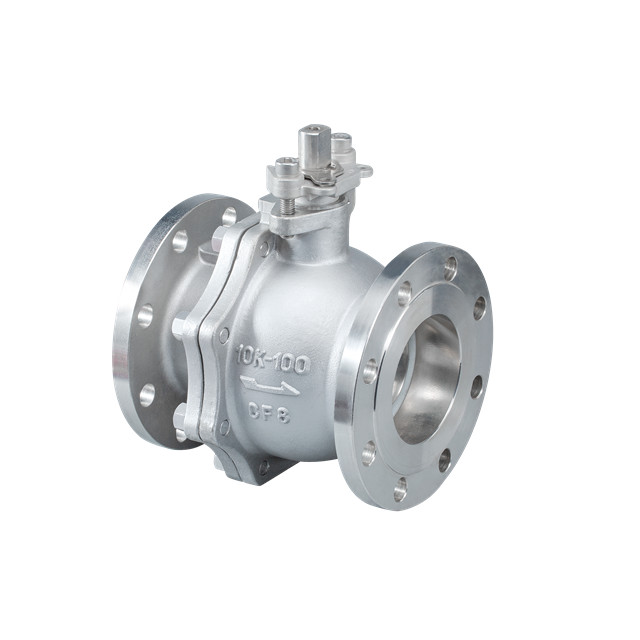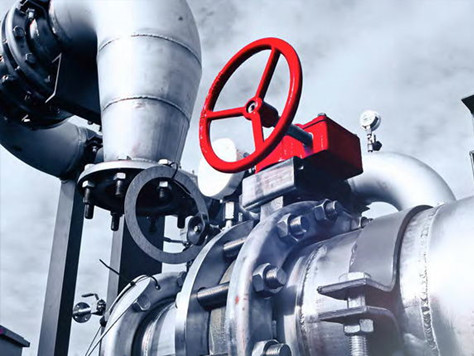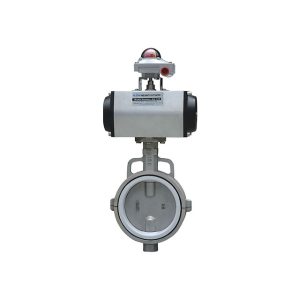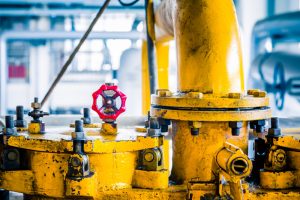Table of Contents
ToggleValves are essential elements in piping systems and play a significant role in transporting useful substances. They’re built to withstand high pressures and be long-lasting, available in various sizes and shapes for different applications.
Fast to operate and cost-effective, these machines also boast a lightweight design. You can choose to operate them manually or automatically through gears, automatic actuators, or handles, depending on their design.
Butterfly valves can be employed in a range of applications, such as water services, chemical usage, and corrosive fluids. There are various types of butterfly valves available such as wafer-style, lug-style, and rotary valves.
What is a Butterfly Valve?
A butterfly valve is an innovative quarter-turn valve that uses a thin disc to regulate fluid flow through pipes. When opened, it allows fluid through, but when closed, it blocks off any potential pathways for the liquid to enter or leave the pipe.
A valve body is a thin metal disc that rotates around a fixed axis (stem assembly). As the stem moves, it transfers motion to the disc, which opens and closes the valve as desired.
Butterfly valves can be operated using various methods, including electric-operated, pneumatically operated, and hydraulic piston operated.
Butterfly valves have many applications, such as throttling services, flow control, and shutoff functions. They regulate the flow of water, air, oil, and other liquids.

Parts Of Butterfly Valves
Butterfly valves are frequently employed to control and throttle flow through piping systems. They can be operated manually via handles and gears or automatically by electric, pneumatic, or hydraulic actuators.
- Body
The valve body is an integral component of a butterfly valve. It serves as the support structure for all other parts and must be made out of high-strength materials that can withstand intense fluid pressures. Valve bodies are usually circular, with a rotating disc that isolates or regulates flow. This action is controlled by an actuator located outside the valve body.
- Stem
The stem of a butterfly valve may seem like an insignificant part, but it plays an essential role in its operation. Without it, the valve would not be able to open and close properly.
The butterfly valve stem is the connection point between the handle and the disc inside the valve. This stem can be constructed as either a single-piece or double-piece shaft.
- Disc
The disc of a butterfly valve is the part responsible for allowing, restricting, or controlling fluid flow within an enclosure. This rotating disc can either be coplanar with the cross-sectional flow area or perpendicular to it. To fully open the valve from its closed position after 90 degrees rotation, turn it 90 degrees clockwise.
- Seat
Butterfly valve seats are essential components of the valve body to prevent fluid leakage. They may be constructed from metal, elastomeric materials, or both.
Seats are engineered to maintain the seal against thermal, friction, and impact stresses. They serve as mechanical stops for the disc when closed and also acted as primary sealing agents when the disc is in its open position.
Types Of Butterfly Valves
Butterfly valves come in a range of sizes to meet various applications. Choose from centric or eccentric, single, double, or triple-offset options – whatever suits your needs!
- Wafer Butterfly Valve
Wafer Butterfly Valve is a general purpose disc type butterfly valve with a fully rubber-lined body and seat, offering 100% bi-directional sealing from vacuum to the rated pressure. This universal fit between pipe flanges of the most popular flange standards comes in replaceable or integrally molded (bonded) versions for added convenience.
Wafer-style butterfly valves are similar to lug-style valves in that they feature non-tapped centering holes around their perimeter and flange bolts surrounding the body. While easy to install and suitable for isolation services, they cannot be used as pipe ends or end-of-line solutions.
- Lug Butterfly Valve
Lug Butterfly Valves are designed to allow fluid flow without obstructions. Their disc rotates a quarter turn in order to open or close it, and these valves come in an assortment of styles and materials.
Lugged butterfly valves are commonly made of metals such as steel or ductile iron and have threaded lugs that allow bolt connections on their flanges. While these valves can be used for end-of-line service, they should always be fitted with a blind flange to prevent leakage.
- Flanged Butterfly Valve
Flanged Butterfly Valves are a type of valve used to regulate fluid flow. These can be operated manually or electronically and come in various materials suitable for various industries.
Flanged butterfly valves are the most commonly used type. Manual flanged butterfly valves typically work within gear systems that transfer torque along a horizontal axis of the valve.
These valves feature metallic seats to withstand extreme temperatures and pressures. They’re easy to maintain, repair, or clean if damaged.
- Welded Butterfly Valve
A welded butterfly valve is one that is butt welded instead of bolted onto pipe flanges. These types of valves are often used in high-pressure applications or other scenarios where pressure resistance is essential. They come in a range of sizes and materials that can be customized to meet specific application requirements.
These valves are widely used in heating systems, chemical processes, petroleum, natural gas refining, and energy production, as well as food applications. They come with either sanitary tri-clamp or butt-welded ends for sanitation.
- Zero-Offset Butterfly Valve
In liquid and gas applications, a zero offset butterfly valve is distinguished by a disc that rotates on its central axis to achieve 360o rotation. This provides full friction between the seat and disc throughout the operating cycle.
The seat is constructed with resilient, soft material and reinforced with metal, which may be reinforced with elastomeric materials or plastics. This allows the seat to withstand moderate pressure and temperatures.
- Double Offset Butterfly Valve
A Double Offset Butterfly valve is a superior performance valve designed for leak-free sealing in water systems. This valve can be utilized with various fluids such as semi-solids, liquids, and gases.
Double offset butterfly valves feature a seat made of an elastomer material like PTFE or Teflon, which offers resistance to abrasion and heat – ideal for applications exposed to corrosives.
- Triple Offset Butterfly Valve
Triple Offset Butterfly Valve is ideal for critical applications requiring bubble-tight shutoff. Their metal-to-metal sealing arrangement offers superior benefits over traditional butterfly valves, providing zero leakage performance and no cavities between the sealing elements.
The Triple Offset Butterfly Valve is designed with three offsets, two of which pertain to the shaft placement in relation to both the bore’s center line and disc/seat center lines. Additionally, an elliptical seat cone angle axis creates a design element designed to minimize disc wedging or binding while decreasing operating torque.
Advantages Of Butterfly Valves
Butterfly valves offer the primary advantage of controlling liquid, gas, and slurry flow. They come in various sizes and design configurations to meet a variety of applications.
Butterfly valves offer several key advantages, including their compact design and versatility in applications. Furthermore, they are lightweight and require minimal upkeep.
They can be installed quickly and cost-effectively by piling systems, saving installation time and effort. Furthermore, their quick 90deg rotation of the handle or actuation system makes them ideal for emergency shutoffs.
These valves can be used in a range of industrial processes, such as pulp and paper manufacturing, food and beverage processing, refineries, power plants, and oil and gas exploration and production. Furthermore, they come in an extensive selection of materials and sizes to suit the requirements of any application.
Butterfly valves boast high reliability and can withstand a variety of operating conditions. Not only are they insensitive to water hammers, but they’re also resistant to extreme temperatures.
In addition to the above, butterfly valves are easy to install and require little upkeep. This makes them a great option for many applications; however, be sure to select an established manufacturer or supplier for your project. Look for companies that provide product warranties as well as customer support teams; this will guarantee you get the best service from your butterfly valves.
Disadvantages Of Butterfly Valves
Butterfly valves have the common disadvantage of being susceptible to cavitation and water hammer damage due to their constant placement in pipes with high air turbulence. Over time, this can corrode the disc, leading to a loss in sealing pressure.
Another disadvantage is that the disk-shaped valve seat can become clogged with debris. This prevents it from opening or closing properly, leading to leaks and other issues.
These valves may not be appropriate for all applications. They’re especially ineffective with viscous or corrosive fluids due to their susceptibility to scouring against the discs of the valve, leading to rapid deterioration and loss of sealing pressure.
Conclusion
Valves are indispensable components in liquid flow processes, whether used for gas, oil, water, or steam. While their various uses make them unique from one another, there are some fundamental characteristics that set them apart.
Xintai Valve is one of the top global valve manufacturers. Their extensive product offerings, which encompass six ranges and thousands of varieties such as control valves, cryogenic valves, gate valves, globe valves, ball valves, check valves, butterfly valves, power station valves, oxygen valves, hydraulic control valves, and thread valves are popular across various industries.










